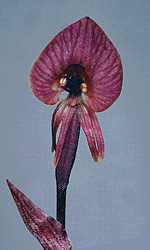 |
This small family of a few species occurs in New Guinea, the Solomon Islands and in north-east Queensland, where it is found in rain forest.
Characteristic features of the family Corsiaceae in Australia include: - more or less leafless perennial with a creeping rhizome and erect flower stalks, parasitic on mycorrhizal fungi
- flowers single at the end of each flower-stalk, orchid-like, zygomorphic with one broad, erect perianth-lobe and 5 narrow, pendulous ones
- stamens 6, in two whorls
- ovary inferior; fruit a capsule with numerous seeds
Description
Perennial terrestrial herbs. Perennating by tubers or rhizomes. Vegetative reproduction by tubers or rhizomes. Leaves ±absent. Chlorophyll absent and the whole plant whitish, yellowish or brownish. Internal secretions not obvious. Plants glabrous. Leaves much reduced, alternate and spiral, cauline, sessile. Stipules absent. Lamina simple, symmetric, lanceolate or ovate; margins entire, ±flat; venation parallel, with the midrib inconspicuous, the tertiary venation not reticulate; surfaces not punctate; membranous or papery. Leaf ligule absent. All the flowers bisexual. Inflorescences terminal, consisting of solitary flowers. Bracts and bracteoles absent. Flowers stalked. Floral disc absent. Perianth irregular, of 1 whorl only or all whorls ±similar, with 6 fused petaloid segments, imbricate in bud, tubular, 1-lipped, yellow or brown, streaked, spotted, etc, membranous; lobes ±entire. Fertile stamens 6, free of the perianth segments, free of the ovary and style, distinct from each other, all ±equal. Anthers dorsifixed, not versatile, opening outwards by longitudinal slits; 2-celled. Ovary inferior. Carpels 3, fused; ovary with 1 locule. Style terminal, single and unbranched, or single and branched above. Ovules numerous, sessile; placentation parietal. Fruit a dry valvular capsule. Disseminule macro-surface featureless or winged; micro-surface ±smooth, brown or grey, dull. Seeds numerous per fruit. Aril absent. Cotyledons 1. Embryo round or shapeless.
(Note: this description has been generated from the coded data compiled for the key. Any errors in the key data will be reflected in the descriptions.)
A treatment of the family Corsiaceae has not yet been published in the Flora of Australia. It will appear in Volume 47.
Australian genera of Corsiaceae (as recognised for the Flora of Australia)
Corsia

|
  |

Corsia sp. (flower)
Photo: M.Clements © M.Clements
|

| |